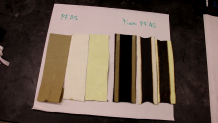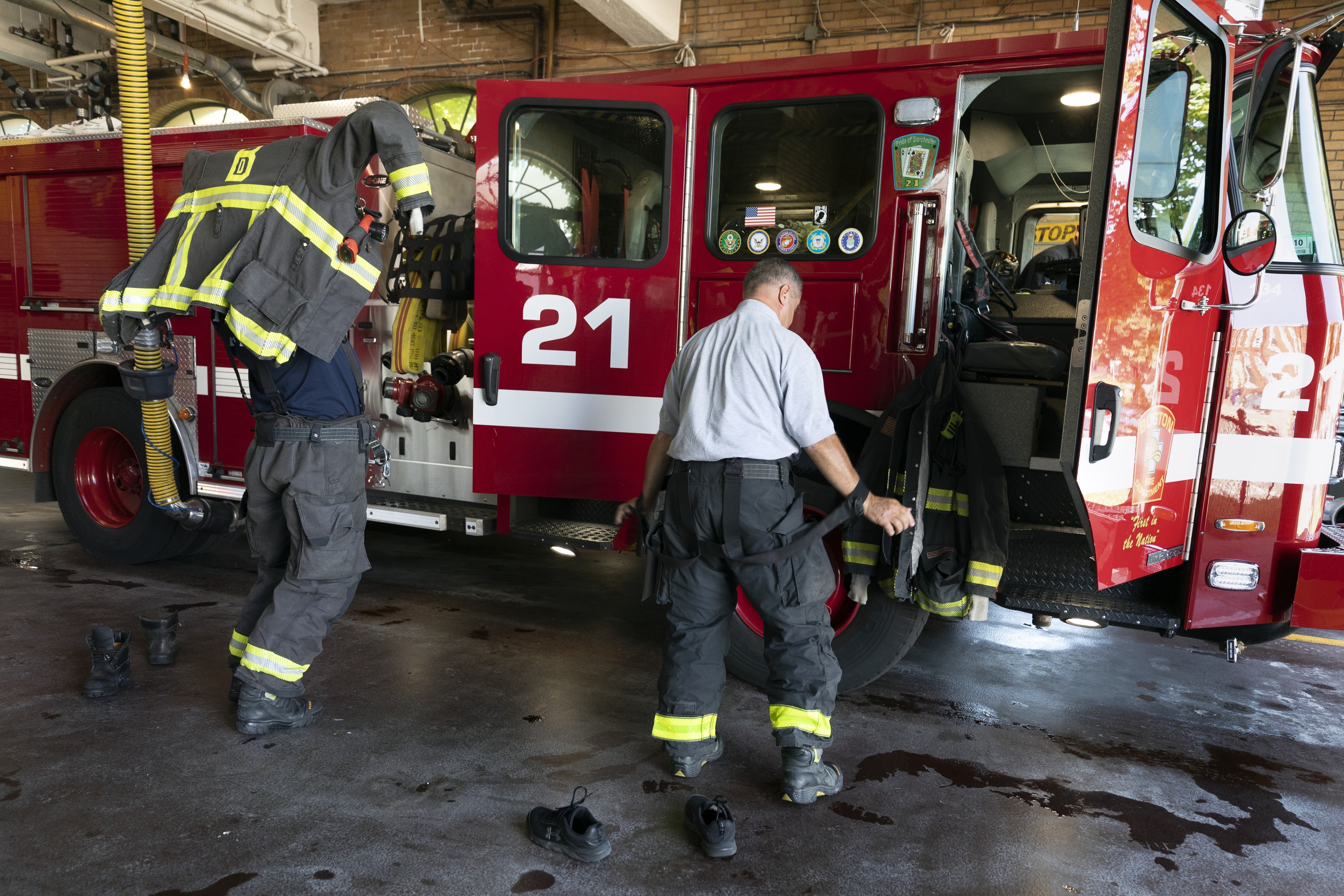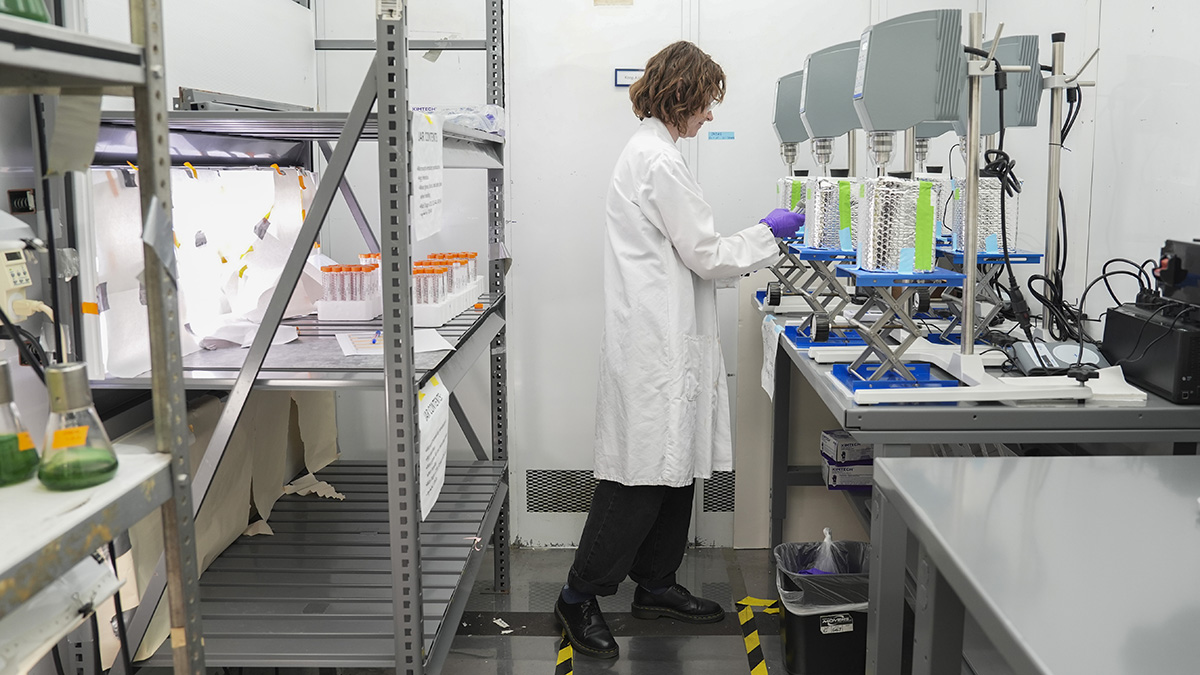Lawmakers in San Francisco are scheduled to vote Tuesday on a first-in-the-nation type of ban, prohibiting the use of protective fire equipment containing chemicals believed to cause cancer.
“We're not willing to negotiate how long we will continue poisoning people,” said Adam Wood, Vice President of the San Francisco Firefighters Cancer Prevention Foundation. “The change has to happen now.”
‘Forever chemicals’ found in gear responsible for protecting firefighters
Wood, who is also a firefighter with a rescue squad based out of San Francisco’s Mission District, is among a vocal group of first responders pushing for the ban of so-called “PFAS” or “forever chemicals,” long-lasting compounds that break down very slowly, which are linked to harmful health effects including increased cholesterol levels, immune system effects, and cancer, according to the Centers for Disease Control and Prevention (CDC).
Get a weekly recap of the latest San Francisco Bay Area housing news. Sign up for NBC Bay Area’s Housing Deconstructed newsletter.
“I definitely don’t want someone else to have to go through what I did,” said Lt. Magaly Saade, a firefighter and training instructor at the San Francisco Fire Department. “I’ve had cancer twice.”
We're not willing to negotiate how long we will continue poisoning people.
Adam Wood, Vice President of the San Francisco Firefighters Cancer Prevention Foundation
Saade, who has spent the past 26 years rushing towards emergencies as a firefighter, underwent radiation and ultimately a double mastectomy as part of her cancer treatment. She believes continually wearing her protective pants and jacket, commonly known as ‘turnouts,’ may have contributed to her diagnosis since they were manufactured with PFAS chemicals.
“To put something in the equipment, [for] people who are already there to risk their life for you, seems really malicious,” Saade said. “A cruel thing to do.”
In San Francisco, female firefighters have a six times higher rate of breast cancer than the national average, according to the San Francisco Firefighters Cancer Prevention Foundation. The department has lost more than 300 firefighters to cancer over the past 20 years. Ongoing exposure to smoke and other chemicals is so serious, the World Health Organization classifies firefighting as a “carcinogen.”

'It’s a lower cost than cancer'
“There is no real fix except to switch the entire stock out [of turnouts] for an alternative that's safer for our firefighters,” Wood said. “Whatever the cost is, it's a lower cost than cancer and it's a lower cost and firefighter lives.”
Each new turnout is expected to cost roughly $3,400, according to a report by the city's Budget Analyst's office. Since it is customary to provide firefighters with two sets of uniforms, outfitting San Francisco's 1,482 firefighters with new clothing, manufactured without PFAS, is estimated to cost $10.1 million. The city was already planning to spend $1.7 million over the next two years to replace older turnouts. Additionally, San Francisco was awarded a $2.3 million grant from FEMA, which can also be used toward the purchase of new gear, leaving the city to come up with the difference of approximately $6 million over the next two years.
“It is morally right and it is financially right,” said Aaron Peskin, President of the San Francisco Board of Supervisors, who authored the legislation to ban PFAS-manufactured gear by July 2026. “Fundamentally, what's at stake is people's lives.”
While Peskin acknowledges the cost isn't cheap, he says doing nothing could force the city to pay an even higher price.
“[The] cost is so small compared to a human life, is so small compared to the cost of health care, is so small compared to the cost of settling lawsuits,” he said.
As with all San Francisco ordinances, the legislation must be voted on twice by the board of supervisors. If approved Tuesday, the proposed ban would require a second majority vote during the next board of supervisors meeting on May 14.

Proponents of the ban are quick to point out the potential health risks associated with PFAS have been known for years. In 2020, a study out of the University of Notre Dame raised serious safety concerns regarding the prevalence of PFAS found in firefighter clothing. Since then, government researchers at the National Institute of Standards and Technology (NIST) published similar findings last year and most recently in January, noting increased levels of PFAS in gear designed to protect firefighters, particularly clothing that has underdone wear and tear.
PFAS chemicals are meant to help turnouts repel flammable liquids and resist extreme heat, but the compounds can also be absorbed through skin and prove to be potentially harmful, according to the Environmental Protection Agency and the National Institute for Occupational Safety and Health (NIOSH). The precise level of exposure for firefighters, however, and the exact health risks are still being studied and remain relatively unknown.
Despite the potential health hazards, alternative gear that does not intentionally use PFAS still is not widely available. Proponents of the San Francisco ban believe instituting a phase out deadline will push more manufacturers to veer away from PFAS chemicals.
Heated lawsuit over safety standards allowing use of PFAS
The International Association of Fire Fighters (IAFF) blames the lack of PFAS-free options on industry standards released by the National Fire Protection Association (NFPA). The IAFF says those standards continue to be written in a way that favor the use of PFAS chemicals by including certain requirements that can’t easily be met using other materials.
The IAFF, which describes itself as “one of the largest and most influential labor unions in North America” representing roughly 334,000 fire fighters, paramedics, and other emergency responders and dispatchers in the U.S. and Canada, is currently suing the NFPA over its standards for firefighter gear. In its lawsuit, the IAFF accuses the NFPA of engaging in “reckless” conduct that was “deceptive and unfair.”
The NFPA has described IAFF’s legal actions as “misguided and ill-informed,” and in legal documents called the IAFF’s claims “deficient.” The NFPA continues to describe itself as a “neutral facilitator during the standards development process” and says it “plays no role in requiring the use of or otherwise enforcing the standards once they are developed by the technical committee comprised of interested parties, including union representatives from IAFF.”
Largest manufacturers of firefighting gear largely silent on PFAS risks
To understand why PFAS continues to be used in turnout gear, the NBC Bay Area Investigative Unit reached out to seven of the largest manufacturers of firefighter protective clothing.
- Lion
- Viking
- Honeywell
- MSA
- Fire-Dex
- Innotex
- Veridian

Denmark-based Viking, which has been selling protective firefighting gear in the US since the 1990s, was the only company to respond and noted there remains a lack of PFAS-free fabrics capable of meeting NFPA’s standards.
Viking, like other manufacturers, has managed to remove PFAS materials from the clothing’s outer most layer, which is responsible for repelling flaming liquids like oil and gas. In most available turnouts, however, the middle layer, commonly known as the ‘moisture barrier,’ continues to contain intentionally added PFAS chemicals in an effort to add breathability to the uniform and safeguard firefighters from the dangers of heat stress, according to industry experts.
“Until recently, durable moisture barriers without PFAS that can adequately protect against the risk of hot water ingress, blood-borne pathogens and chemicals have not been available,” said Malte Vermehren Eggers, Viking’s corporate communications manager. “When we have a tested and certified PFAS-free moisture barrier, then we will be able to provide turnout gear without intentionally-added PFAS chemicals.”
Eggers says Viking is now examining alternative materials in hopes of releasing a new line of protective gear by the end of the year that is not manufactured with PFAS.
At least three other companies, Fire-Dex, Lion, and Honeywell are already advertising protective gear manufactured without PFAS. As part of a test trial orchestrated by the IAFF, turnouts from those three manufacturers are currently being tested in select cities, including Miami, Denver, and San Francisco. The trial, which began in February, is expected to last up to 90 days with the IAFF hoping to release preliminary results from its study sometime this summer.

Turnouts made without PFAS now being tested in select cities
- Miami, Florida
- Prince George’s County, Maryland
- Ottawa, Canada
- Denver, Colorado
- San Francisco, California
In San Francisco, after just a few months of testing, Wood says the gear appears to be performing as designed.
“In terms of working in a fire, allowing us to do our job, protecting us from heat – I have nothing but good things to report,” Wood said.

Warnings about trading ‘one hazard for another’
Nearly 3,000 miles away in Raleigh, North Carolina, Dr. Bryan Ormond is trying to determine whether those alternatives will be safer for firefighters, long term.
“We don't want to just trade one hazard for another,” said Ormond, who is a chemist and assistant professor of Textile Engineering at North Carolina State University. “We have to ask the questions of what the tradeoffs are, what can possibly happen.”
Ormond says his research, so far, has shown removing PFAS can make firefighter uniforms less breathable and more susceptible to burning.

We don't want to just trade one hazard for another.
Dr. Bryan Ormond, professor of Textile Engineering at North Carolina State University
“We're introducing a potential hazard for flammability on the fire scene where firefighters didn't have that before,” he said.
Ormond found alternative fabrics can be up to 60% less repellant than traditional turnouts that utilize PFAS, which means the clothing is more likely to absorb flammable liquids, like diesel, and catch on fire.
“One of our biggest concerns is if a firefighter responding to a fire gets exposed to one of these flammable liquids and then is still responding with an open flame, that's where we can have the most hazard,” he said.
Ormond, however, cautions what he has seen in the lab could differ from what firefighters might experience on the front lines.
“It comes down to what do firefighters actually need,” he said. “We always have to go back and ask what can the firefighter actually feel.”
Contact The Investigative Unit
submit tips | 1-888-996-TIPS | e-mail Bigad




